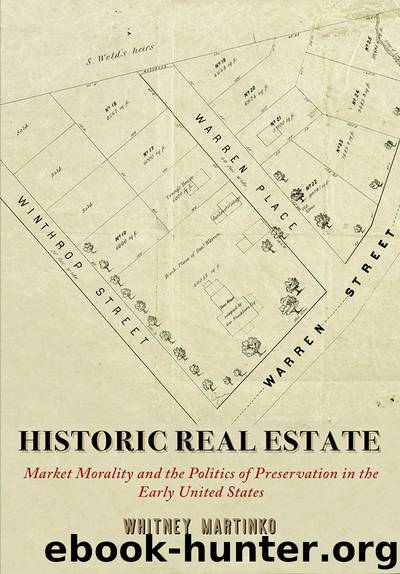Historic Real Estate by Whitney Martinko

Author:Whitney Martinko [Martinko, Whitney]
Language: eng
Format: epub
ISBN: 9780812296990
Publisher: University of Pennsylvania Press, Inc.
Published: 2020-06-15T00:00:00+00:00
Figure 23. Nathaniel Currier hoped to profit from popular interest in the homes of famous men when he published this lithograph of the birthplace of Joseph Warren in 1840. His view presents a different image from the dilapidated one that Rebecca Warren Ball described in her 1835 biography of Warren: Currier shows a neatly kept, if old-fashioned, clapboard farmhouse and picket fence. The contrast of Currier’s and Ball’s characterizations exemplifies competing visions of the value of old houses for modern U.S. society. Nathaniel Currier, “The House in Roxbury, Mass. (As It Now Stands, August, 1840) in which General Joseph Warren was born in the year 1741.” Collection of the Massachusetts Historical Society.
Rebecca Brown and John Collins Warren defined an evolutionary mode of preservation with rural improvement to participate in broader conversations about the social effects of inheritance. At a moment when most U.S. residents saw landed inheritance in terms of monetary rather than productive value, observers questioned whether permanent family holdings constituted laudable social stability or the consolidation of aristocratic wealth. Interlocutors on both sides of the argument supported their claims with family genealogies and progressive narratives of historical change defined by the process of civilization. Some argued that perpetual family estates preserved colonial forms of property ownership that inhibited the free circulation of property. In their minds, the division of inherited real estate enabled the economic independence necessary for democratic citizenship. Others forged an argument for estate preservation at the intersection of sentimental domesticity and environmental sustainability. Heirs who maintained ancestral estates with rural improvement, they argued, cultivated a modern form of domestic permanence that promoted civic health by nurturing an intergenerational attachment not only to family homes but also to historic places.
Men who shaped their ancestral estates with this evolutionary form of preservation sought to capitalize on the transformation of agrarian lands into suburban developments. They used the architecture of rural improvement to fix environmental remnants of the past not in “original” forms but in transformations of distinctive features. In this way, they promoted modern standards of domestic privacy by redirecting public interest from domestic interiors to landscape views. But they also constructed a logic of preservation that sanctioned the subdivision of inherited property for new land and labor markets. They used Downing’s revivalist forms to inscribe agricultural pasts of extensive land holding into domestic gardens, renovated houses, and newly grafted trees. If heirs could preserve ancestral estates as living memorials, they could make their historic properties permanent while selling unproductive lands—or even unprofitable people.3 This mode of preservation encouraged men to imagine themselves as ancestral patriarchs of the future while affirming the moral leadership of historic estate proprietors at the top of racial, gender, and social hierarchies. But as more proprietors reshaped ancestral estates with rural improvement, critics deployed the politics of demolition to challenge the ability of familial heirs to preserve historic estates as sites of public interest.
Download
This site does not store any files on its server. We only index and link to content provided by other sites. Please contact the content providers to delete copyright contents if any and email us, we'll remove relevant links or contents immediately.
Kathy Andrews Collection by Kathy Andrews(10507)
The remains of the day by Kazuo Ishiguro(7542)
Spare by Prince Harry The Duke of Sussex(4188)
Paper Towns by Green John(4163)
The Body: A Guide for Occupants by Bill Bryson(3789)
Be in a Treehouse by Pete Nelson(3206)
Harry Potter and the Goblet Of Fire by J.K. Rowling(3025)
Goodbye Paradise(2949)
Never by Ken Follett(2873)
Into Thin Air by Jon Krakauer(2695)
The Remains of the Day by Kazuo Ishiguro(2614)
The Genius of Japanese Carpentry by Azby Brown(2602)
The Cellar by Natasha Preston(2592)
Drawing Shortcuts: Developing Quick Drawing Skills Using Today's Technology by Leggitt Jim(2528)
120 Days of Sodom by Marquis de Sade(2428)
Architecture 101 by Nicole Bridge(2348)
The Man Who Died Twice by Richard Osman(2290)
Machine Learning at Scale with H2O by Gregory Keys | David Whiting(2267)
Fairy Tale by Stephen King(2058)
